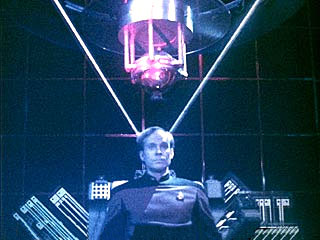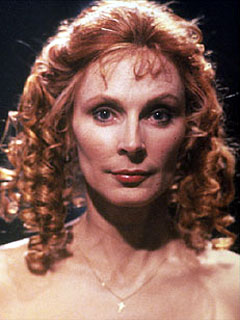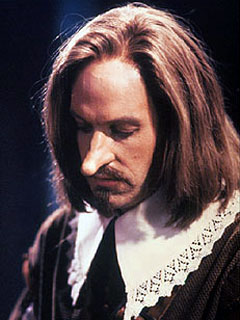When the U.S.S.
Enterprise sets out to repair the Argus Array, a
telescope that has stopped relaying data for two months,
the crew discovers an alien probe near the telescope.
Geordi takes Barclay, a notoriously shy crew member, to
investigate. As they near the probe, it emits an energy
surge that knocks Barclay unconscious, and he and Geordi
are transported to Sickbay. Meanwhile, the probe begins
to follow the starship, emitting a dangerously high
energy level. When the crew is unable to evade it,
Barclay amazes everyone by taking charge of the
situation and eliminating the probe, saving the ship
from destruction.
Turning back to the task of repairing the telescope,
Geordi estimates the job will take three weeks. But
Barclay, whose confidence and intelligence are
continuing to grow, claims he can complete the job in
two days. Geordi's pride in Barclay turns to concern,
however, when he discovers his crewmate in the Holodeck
arguing scientific theory with a simulated Einstein.
Geordi insists to Barclay that the encounter with the
probe must have precipitated the change and drags him to
Sickbay, where Beverly Crusher's examination reveals an
astounding change in Barclay's brain tissue that has
rendered him the most advanced human being who ever
lived.
Although the crew is
frightened by the change in Barclay, the fact that they
need him to repair the Array convinces them to leave him
alone. As the repairs progress, however, the ship's
computer is unable to work fast enough, creating the
danger of a reactor failure in the telescope that could
cause a deadly explosion. Picard orders an immediate
retreat, but is informed that the Bridge has lost
control of the computer. However, before panic can set
in, the computer comes back on line and the crew learns
the telescope has been saved. When Picard asks the
computer to tell him how the disaster was averted, he is
shocked when Barclay's voice answers.
Barclay explains that
since the computer was too slow, he connected his brain
to the computer to save the Array. Picard demands the
engineer disconnect himself, but Barclay replies that
this will cause his death. As the crew tries to devise a
plan to regain control of the ship, Barclay propels the
U.S.S. Enterprise to a point thirty thousand light-years
away.
Before the crew can
stop Barclay an alien suddenly appears on the Bridge,
admitting that the probe transformed Barclay so he would
bring the starship to him. The alien goes on to explain
that this is his civilization's method of researching
new races. Picard agrees to let him scan the brains of
crew members if the aliens will transfer their knowledge
of tens of thousands of civilizations into the
starship's computer. As they talk, Barclay arrives on
the Bridge, having been returned to normal by the
aliens, but retaining a bit of the confidence and
intelligence his experience gave him. |
| Jonathan Frakes Bio:
Jonathan Frakes was born
August 19, 1952, in the small town of Bellefonte, in
central Pennsylvania. His father, James, and his mother,
Doris, soon moved with Jonathan and his younger brother
Daniel to Bethlehem, in eastern Pennsylvania. There Dr.
Frakes taught English at Lehigh University, where he
held the Fairchild chair in American Literature until
his death in 2002. While growing up, Jonathan was
introduced to jazz by his father, and started playing
the trombone when he was in fourth grade. As a child
Jonathan was always friendly, funny and somewhat of an
actor, according to a childhood friend.
In high school he
played in the band and ran track. He graduated from
Liberty High in Bethlehem in 1970. The day after he
graduated he started classes at Pennsylvania State
University, enrolling as a psychology major. The next
summer he worked as an usher for the local theater, and
observed his peers thoroughly enjoying acting. He was
motivated to switch his major to theater arts, and
graduated with a bachelor's degree in 1974. He then
moved to Boston to attain his masters degree from
Harvard University by 1976.
At this point he
decided to move to New York City and try to make it as
an actor. The roles didn't come easy, so he had to take
side jobs, such as a waiter, a furniture mover (where he
injured up his back), and a stint as Captain America for
Marvel Comics. Meanwhile, he won roles in the Broadway
musical "Shenandoah" and on the soap opera "The Doctors"
(1969) as Vietnam vet Tom Carroll from 1977 to 1978.
At his agent's urging,
Jonathan moved to Los Angeles in late 1978 to try his
hand at television guest appearances. He guest-starred
on several of the big primetime shows of the time,
including "Charlie's Angels" (1976), "Fantasy Island"
(1978), "Barnaby Jones" (1973), _"Quincy" (1976)_ ,
"Highway to Heaven" (1984), "The Waltons" (1972) and
"The Dukes of Hazzard" (1979).
During the 1980s
Jonathan landed a starring role in a prime-time soap
opera, "Bare Essence" (1983), which had spun off a
successful miniseries of the same name. The show didn't
take off with the viewers, however, and was soon
canceled. He went back to guest appearances for two more
years, until he got the part of Stanley Hazard in the
Civil War epic "North and South" (1985) (mini). After
spending more than six months filming all over the
southern United States, he and his co-star, Genie
Francis, fell in love (he had met her three years before
when they co-starred in "Bare Essence"). During that
time he and Genie didn't have much to do with each
other, other than his making fun of her hair, according
to her. Three years later, however, they were an item.
In early 1987 Jonathan
went to an audition for a new television series at the
urging of his soon-to-be wife and her family. After six
weeks, and seven auditions, he won the role that would
bring him worldwide fame: that of Cmdr. William Riker on
"Star Trek: The Next Generation" (1987). It was at this
time he and Genie announced their engagement. They would
have to postpone their wedding twice because of his job,
but were finally married in the first-season hiatus on
May 28, 1988. All of his new co-stars attended the
wedding, along with "Star Trek" creator Gene
Roddenberry. During the seven years Frakes starred on
ST: TNG, he not only acted but discovered that he had a
talent for directing. He helmed eight episodes in all,
and was invited to direct on the Next Generation
spin-offs, "Star Trek: Deep Space Nine" (1993) and "Star
Trek: Voyager" (1995).
The day after his 42nd
birthday, on August 20, his son, Jameson Ivor Frakes was
born. Jameson is named after both his grandfathers, the
late James Frakes, and the late actor Ivor Francis,
Genie's father. During this time Jonathan actually
turned down work, preferring to stay at home and raise
his son with his wife. For the next two years, he did a
few guest appearances on television.
In 1996 it was
announced that he was to be the director of the next
Star Trek film, Star Trek: First Contact (1996). He
received critical praise for his work on the film, and
it became the highest-grossing entry of the franchise to
date. He formed a production company, Goepp Circle
Productions, named after the street he lived on in
Bethlehem, Pennsylvania. Just two days after his ninth
wedding anniversary in 1997, Elizabeth Francis Frakes
was born. Sadly, just two weeks prior, Jonathan's
brother, Daniel, passed away from pancreatic cancer.
In 1998 he was asked
to direct the ninth Star Trek film, Star Trek:
Insurrection (1998). Following mixed reviews for this
film, he continued to direct in movies and television,
act in a few non-Star Trek roles, and starred in the
tenth Star Trek film, Star Trek: Nemesis (2002).
|



